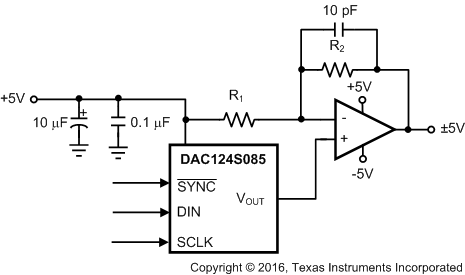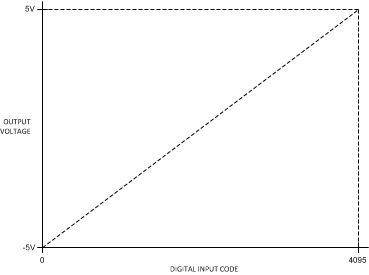SNAS348G May 2006 – April 2016 DAC124S085
PRODUCTION DATA.
- 1 Features
- 2 Applications
- 3 Description
- 4 Revision History
- 5 Description (continued)
- 6 Pin Configuration and Functions
- 7 Specifications
- 8 Detailed Description
- 9 Application and Implementation
- 10Power Supply Recommendations
- 11Layout
- 12Device and Documentation Support
- 13Mechanical, Packaging, and Orderable Information
Package Options
Mechanical Data (Package|Pins)
Thermal pad, mechanical data (Package|Pins)
- DSC|10
Orderable Information
9 Application and Implementation
NOTE
Information in the following applications sections is not part of the TI component specification, and TI does not warrant its accuracy or completeness. TI’s customers are responsible for determining suitability of components for their purposes. Customers should validate and test their design implementation to confirm system functionality.
9.1 Application Information
Figure 35 is an example of the DAC124S085 in a typical application. This circuit is basic and generally requires modification for specific circumstances.
9.2 Typical Application
9.2.1 Bipolar Operation
The DAC124S085 is designed for single-supply operation and thus has a unipolar output. However, a bipolar output may be obtained with the circuit in Figure 35. This circuit provides an output voltage range of ±5 V. A rail-to-rail amplifier must be used if the amplifier supplies are limited to ±5 V.
 Figure 35. Bipolar Operation
Figure 35. Bipolar Operation
9.2.1.1 Design Requirements
- The DAC124S085 uses a single supply.
- The output is required to be bipolar with a voltage range of ±5 V.
- Dual supplies are used for the output amplifier.
9.2.1.2 Detailed Design Procedure
The output voltage of this circuit for any code is found with Equation 2.
where
- D is the input code in decimal form
Equation 3 is calculated with VA = 5 V and R1 = R2.
A list of rail-to-rail amplifiers suitable for this application are indicated in Table 2.
Table 2. Some Rail-to-Rail Amplifiers
| AMP | PKGS | VOS (TYP) | ISUPPLY (TYP) |
| LMC7111 | DIP-8 SOT23-5 |
0.9 mV | 25 µA |
| LM7301 | SO-8 SOT23-5 |
0.03 mV | 620 µA |
| LM8261 | SOT23-5 | 0.7 mV | 1 mA |
9.2.1.3 Application Curve
 Figure 36. Bipolar Input and Output Transfer Characteristic
Figure 36. Bipolar Input and Output Transfer Characteristic